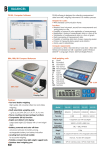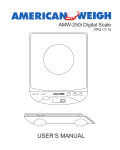Download American Weigh Scales LB-3000
Transcript
American Weigh Scales LB-Series User Manual LB-1000 (1000g x 0.1g) LB-3000 (3000g x 0.1g) Copyright © 2010 American Weigh Scales, Inc. All rights reserved. Rev. 2.1 LB-Series Manual Thank you for purchasing the American Weigh LB-Series compact bench scale. Please read all operating instructions carefully before use. Scales are precision measuring devices and should always be handled with proper care. To ensure years of reliable service, keep these simple tips in mind: • • • • • • • • • • Do not exceed the scale’s maximum capacity. Overloading your scale can permanently damage it! Avoid exposure to extreme heat or cold. Scales perform best at normal room temperature. If temperatures have changed dramatically, calibration and adjustment may be necessary. Allow your scale to warm up for 30-60 seconds before performing calibration and adjustment(if available). Store your scale in a clean, dry location. Dust, dirt, and moisture can accumulate on the weighing sensors and electronics causing inaccuracy or malfunction. Avoid using your scale in close proximity to strong radio wave emitting devices such as computers, cash registers, and cordless phones. Always weigh on a flat and level surface, free from vibrations and drafts. The corner of a room is usually the most stable. Gently apply all items to be weighed. Do not drop items onto the weighing platform. Avoid dropping your scale. The warranty does not cover damage due to rough treatment or overload. Check the batteries first if you are having any trouble with your scale. This simple step can remedy most scale issues. Do not disassemble your scale. This product contains no user serviceable parts. I. Part List 1. 2. 3. 4. 5. Scale Expansion Bowl 200g Calibration Weight (x2) *LB-1000 ONLY* AA Batteries (x4) AC Adapter II. Key Description Backlight ON/OFF ON/MEM Key ON MEM CAL MODE OFF TARE PRINT OFF Key CAL / MODE Key TARE / PRINT Key III. Battery Installation 1. Before using the scale for the first time, check the battery compartment and remove any plastic insulation strips or packaging that may be in place to prevent battery drainage during shipping/storage. 2. If you are replacing the batteries, make sure the positive and negative contacts are properly aligned. - + - + + - - + LB-Series Manual IV.Operation 1. Place the scale on a flat, level surface and press the ON/MEM key to turn the scale on. 2. Once the start-up process completes and the scale goes to zero you are ready to weigh. 3. Place the quantity to be weighed onto the weighing platform. 4. Wait a couple seconds for the display to stabilize before taking a weight reading. V. Changing the Unit of Measure 1. Press the MODE/CAL key to change the scales displayed unit of measure. 2. If the scale is turned off then back on, it will default to the last unit used. • LB-1000 & LB-3000 Units: g (gram) ozt (troy ounce) dwt (pennyweight) oz (ounce) VI.Using the Tare Feature You can use this scale’s tare feature to subtract the weight of an empty container or vessel for net weight determination. NOTE: The weight of the container will subtract from the available capacity. 1. Place the empty container or vessel on the weighing platform. 2. Press the TARE/PRINT key once. The display will then reset to zero. If the container is removed, it’s weight will be displayed as a negative number. 3. You may now fill the container with the quantity to be weighed. The display will show the net weight of the contents. 4. To return to normal weight display (gross weight), remove any items from the weighing platform and press the TARE/PRINT key again to re-zero the scale. VII. Counting Feature 1. To enter parts counting mode, press CAL/MODE to scroll through the weighing modes until “C” appears on the bottom left of the display. The minimum sample quantity is 5 and will be displayed as “S=5” 2. Continue to press the CAL/MODE key to select the desired parts sample quantity: 5, 10, 20, 50 pieces. After “50” is displayed the scale will cycle back to g (grams). 3. With the sample quantity value still displayed on the LCD, place the sample quantity on the platform. Allow the sample to stabilize for 3~5 seconds then press TARE/PRINT. The sample quantity is now set. 4. You can now add any number of the item on the scale and a count will be displayed. VIII. Memory Function 1. With the balance on, press the TARE/PRINT key to ensure the balance is zeroed. 2. Place an item on the scale and press ON/MEM when the display is stable. This action adds the displayed weight into the memory buffer which is normally set to zero. The display will show “0.0” again. 3. Repeat step 2 above as many times as you need, until you are ready to see the cummulative result. 4. To view the cummulative weight, press ON/MEM. The total is displayed and memory cleared. LB-Series Manual 5. Press TARE/PRINT again to zero out the balance and the scale is ready for normal weighing again. IX.Calibration Calibration and adjustment are performed at the factory. However, the weighing range can shift slightly during shipping. Also, due to changes in local acceleration of gravity around the world, adjustment is recommended when moving the scale from one location to another. To check calibration: 1. Place the required calibration weight on the scale and note the displayed value. 2. If the displayed value is not within acceptable tolerance (see chart below), adjustment is required. Model LB-1000 Acceptable Tolerance (±) 0.2g Calibration Weight 400g Recommended Accuracy Class OIML M2 LB-3000 0.2g 1000g OIML M2 X. Adjustment 1. Press and hold the MODE/CAL key until the display shows “CAL”. 2. Press the MODE/CAL key again. The display will flash “CAL” followed by the calibration weight value (see chart). 3. Place the calibration weight on the center of the weighing platform. Make sure you are using the correct weight for your specific model. 4. Once the weight is accepted, the display will show “PASS” then return to normal operation. Calibration is complete! XI.Troubleshooting • Problem: Scale will not turn on • Solution: Check the batteries • Problem: Displayed weight fluctuates randomly • Solution: Make sure your workspace is stable and free of any air currents or vibration • Problem: Displayed weight is inaccurate Solution: Perform a calibration adjustment • XII. Error Codes 1. E - Calibration error. Repeat calibration. 2. O-Ld - Maximum capacity exceeded. Remove the extra weight to avoid damaging the load cell. 3. - Batteries are low. Replace the batteries. Max. Capacity Readability Power Dimensions Platform Dimensions Warranty LB-1000 1000g 0.1g LB-3000 3000g 0.1g 4 x AA 7.3 x 5.5 x 1.5” 5.2” Ø 10 Year Limited Warranty LB-1000 LB-3000 1000x0.1g 35.27x0.005oz 32.15x0.005ozt 643.1x0.1dwt 3000x0.1g 105.82x0.005oz 96.45x0.01ozt 1929x0.1dwt














